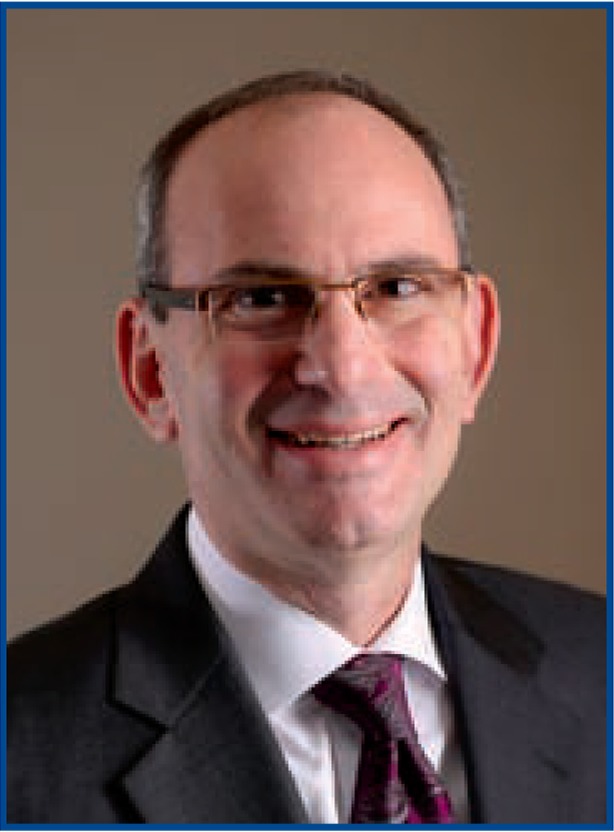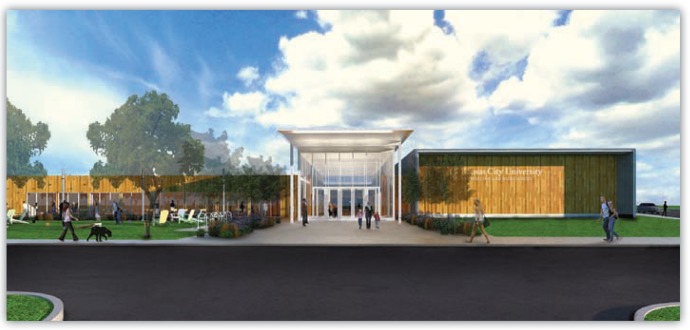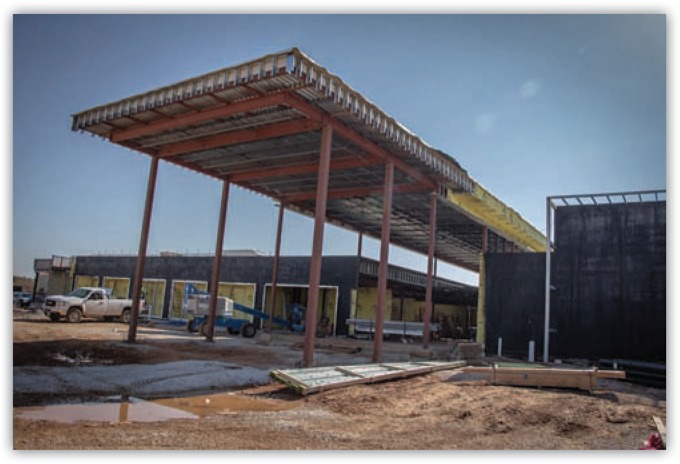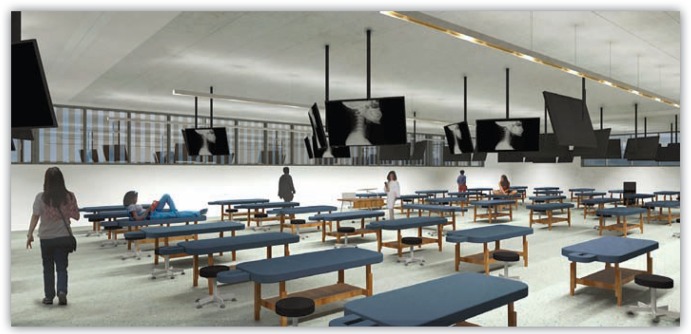As early as 2008, concerned business leaders and medical professionals in Joplin, Missouri, began dedicated conversations about the growing problem of providing adequate health care to its residents for the long term. The area’s population was on the rise; moreover, much of the largely rural four-state region was aging. Compounding the problem was the looming shortage of physicians facing our country — a number projected to reach between 14,900 and 35,600 for primary care physicians and between 37,400 and 60,300 for other specialties by 2025.1 With well over 60 percent of our alumni practicing in a primary care specialty and 40 percent practicing in rural or underserved areas, Kansas City University of Medicine and Biosciences (KCU) was a logical participant in those early discussions.
At the same time, studies revealed that osteopathic medicine ranked as the fastest-growing health care profession in the country, positioning it well to help close the country’s physician supply gap. Since 1985, the number of DOs in practice has grown an average of 25 percent every five years, from 24,014 in 1985 to more than 100,000 today.2 Enrollment in osteopathic medical schools is also witnessing exceptional growth. Between 2002 and 2015, first-year enrollment grew 137 percent (from 2,968 students to 4,057) and is projected to continue its upward trend through 2020.3 KCU’s own experience bears out that trend. Between 2014 and 2015 alone, applications to our College of Osteopathic Medicine increased 39 percent and remained high for 2016.
Indeed, medical centers and many smaller hospitals in the Joplin region all reported difficulty in recruiting and retaining qualified physicians. When community leaders and medical professionals turned their attention to the pipeline of young, new doctors entering the area, local university administrators revealed that interested undergraduates were being forced to relocate to Little Rock, Arkansas; Columbia, Missouri; Kansas City, Missouri; Tulsa, Oklahoma; and St. Louis for their training. What’s more, studies show that approximately 50 percent of physicians choose to permanently locate within 75 miles of where they complete their residency, leaving little hope for a critical mass of Joplin area graduates to return to their local community to practice medicine.4
The solution became clear: If the region was to strengthen and expand high-quality medical care for its growing, aging and rural population, it needed to attract medical students and provide local opportunities for them to study, complete their residencies and practice as physicians in the area. It needed its own world-class medical school.
A Community Rallies
Although conversations with KCU stalled for several years, those initial discussions resulted in the first major step toward the realization of a new medical school for southwest Missouri: the creation of the Joplin Regional Medical School Alliance (JRMSA) in 2010. The goal of the not-for-profit JRMSA was to develop ways to support a new medical school and serve as a community advisory body committed to achieving the mission. Comprised of more than 30 dedicated community and medical sector leaders, JRMSA was poised for action.
Right, rendering of main entrance.
Below, construction photo of main entrance.
However, the evening of May 22, 2011, marked a devastating turn of events when an EF5 tornado destroyed nearly 25 percent of the town. By all accounts one of the deadliest tornados in U.S. history, it cut a 13-mile swath three-fourths of a mile wide through town leaving 161 fatalities and more than $2 billion in damage in its aftermath. Joplin lost five of its schools and one of its two hospitals in the destruction, as well as 7,500 homes and 500 businesses — all in the span of 20 minutes.
As often happens in communities as tightly woven as Joplin, the town and its citizens rallied. Despite taking a direct hit, the medical community persevered. Within six days of the tornado, the Missouri Medical Assistance Team had deployed an 8,000-square-foot field hospital to temporarily replace the destroyed Mercy Health System’s St. John’s Hospital. In short order, the tent hospital gave way to portable buildings and finally a modular structure. During that time, plans also were conceived for an 880,000-square-foot permanent hospital on a new site, built to withstand tornadic winds with safe zones on every floor. The new 207-bed Mercy Hospital opened in March 2015.
In January 2014, discussions had resumed between JRMSA and KCU’s new administration to determine the resources and commitments necessary for developing a successful, world-class medical school with a focus on primary care and rural health. The confluence of events leading up to those discussions served to galvanize support for the project.
The proposed medical school had garnered strong interest by a large number of regional leaders. The area’s two health systems — Mercy and Freeman — and local physicians had agreed to provide student rotation slots, as well as develop additional graduate medical education positions. KCU, one of the oldest osteopathic medical schools in the country, had offered an accredited program and a proven, century-long history of educating physicians to help quell the region’s projected shortage. And a resilient town had united around the rebirth of its community, including a commitment to train physicians locally to improve access to health care for its residents.
With that, JRMSA pledged — and extraordinarily raised in less than one year — $30 million to assist in the construction of the medical school. And, most generously, Mercy Health System donated both its 150,000-square-foot temporary structure valued at $10 million, and the 40-acre plot of land it sat on, for use by KCU in the creation of a new Joplin campus.
Rising From The Ashes
On March 30, 2015, ceremonial shovels dug into the earth as KCU officials, Joplin community partners, government officials, and a cheering crowd of supporters kicked off the start of construction. To be built on the very grounds of the destroyed St. John’s Hospital, the first new medical school in Missouri in almost 50 years was embraced as both a boon to the region and a jewel in the crown of southwest Missouri.
As the 12th largest medical school in the U.S., KCU has distinguished itself as a national leader in the education and training of osteopathic physicians, having graduated more than 10,000 highly skilled, compassionate doctors since its founding in 1916. KCU-Joplin will welcome its first class of 150 students in the fall of 2017. Once fully operational, the Joplin campus will infuse an estimated $111 million annually into the regional economy and add approximately 100 new jobs in the area.
Rendering of the osteopathic manipulative medicine lab.
A Continued Commitment To Academic Excellence And Student Success
At the beginning of the 2014–2015 academic year, KCU adopted a new Modified Systems-Application Based curriculum with the goal of best preparing medical students for a lifetime of future learning and patient care. This innovative curriculum will be integrated into the Joplin campus as well.
Using a proven trans-disciplinary, system-based/interactive model, new students will be immersed in hands-on clinical experiences from their first day. Clinical enhancements, such as human patient simulation and standardized patient training, will augment the teaching of vital patient-physician skills. In third and fourth years, students will train in both ambulatory and hospital sites in Joplin and the surrounding region. Advanced clinical training will be provided through both inpatient and outpatient clerkships in a variety of medical settings.
KCU-Joplin’s physical campus also is being developed with student success at the forefront, encouraging learning through active experiences. Classrooms have been designed with flexibility and technology in mind, enabling students to work in small pods that encourage discussion and collaboration.
The school’s simulation suite will include 24 standardized patient exam rooms and three simulation rooms featuring high-fidelity, programmable robots in fully equipped medical, surgical, obstetrical and trauma settings. Audio-visual capabilities will allow instructors to interact in real time with students while recording procedures to be used as learning opportunities in separate classrooms. Extensive video conferencing capabilities will connect the Joplin campus to the Kansas City campus, allowing students, faculty and staff to share learning opportunities.
The Fruition Of A Shared Vision
Because of a 100-year history of success in medical education and the ability to share existing resources, KCU has accelerated the process of fully establishing a four-year medical school in Joplin as an additional site for its accredited Kansas City program, thus reducing the overall development timetable by approximately two years. With construction scheduled for completion in May 2017, KCU-Joplin will become the seventh medical school in the state and the first in the southwest region of Missouri.
At its heart, KCU-Joplin is a story of unity, community and collaboration. It represents a shared purpose and vision, from which Joplin has never wavered. It is the result of a genuine grassroots effort led by tireless individuals and local organizations, whose remarkable determination and generosity is a symbol of the amazing rebirth that has come from the ashes of tragedy. And it is an example of collaboration at its best, whereby two health systems, area physicians, and local institutions have shown creativity and cooperation to help educate “homegrown” physicians to address the primary care and rural health needs of its four-state region.
In doing so, KCU and the Joplin community have established an innovative approach to expanding medical education that not only serves as a model for our country, but also ultimately advances the University’s mission of “improving the well-being of the communities we serve.”
Biography
Marc B. Hahn, DO, MSMA member since 2012, is the President and Chief Executive Officer of the Kansas City University of Medicine and Biosciences.
Contact: president@kcumb.edu

References
- 1. Association of American Medical Colleges. 2016 Update: The Complexities of Physician Supply and Demand: Projections from 2014 to 2025. April 5, 2016. [Google Scholar]
- 2. American Osteopathic Association, 2015 Osteopathic Medical Profession Report.
- 3. Association of American Medical Colleges, Results of the 2015 Medical School Enrollment Survey.
- 4.Regional Medical School Alliance. A Medical Vision. p. 2.





